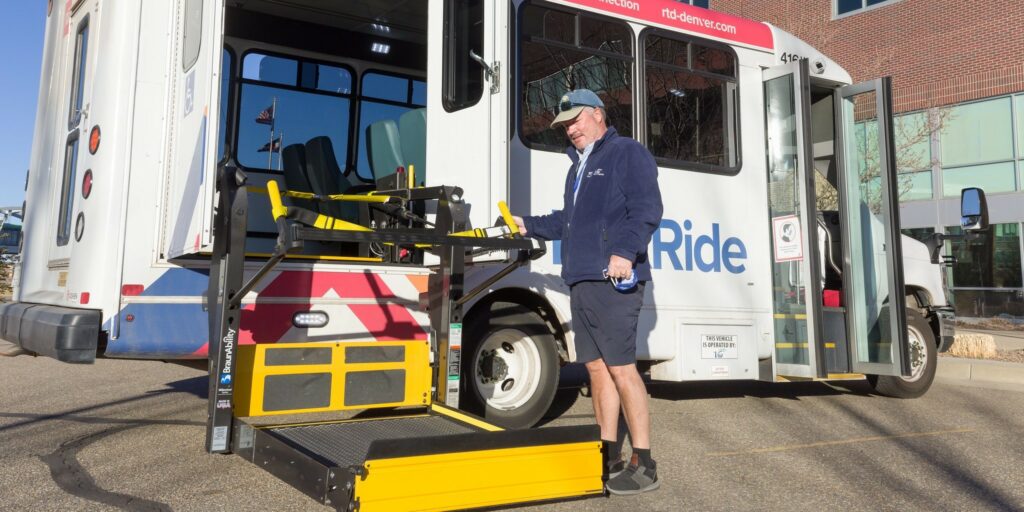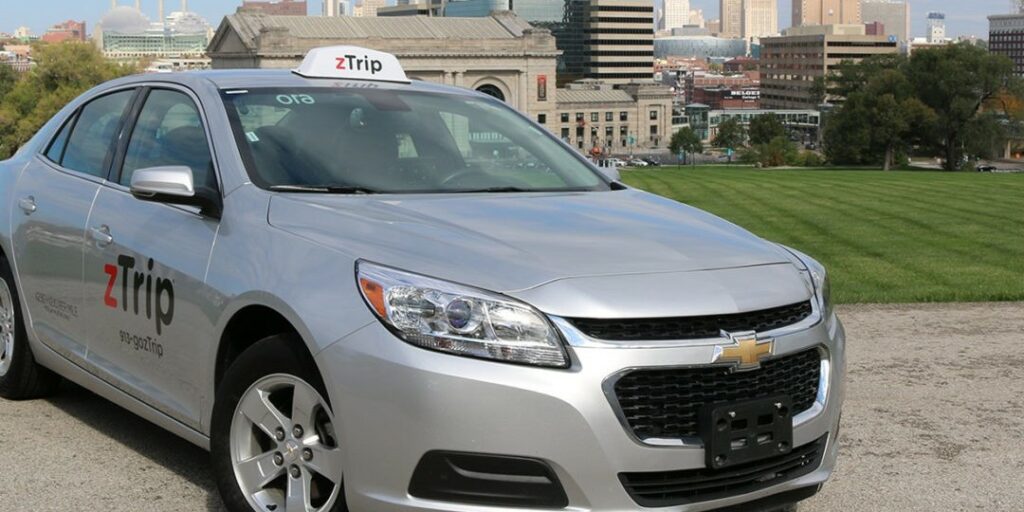GDT > RTD Rider’s Guide > Paratransit

RTD offers two paratransit services or individuals with disabilities who are unable to use regular fixed-route bus or light rail services. The first service, Access-a-Ride (AaR), is a fully Americans with Disabilities Act (ADA) compliant door-to-door van service that can take riders in wheelchairs and other mobility devices. The second service, Access-on-Demand (A0D), is aimed at individuals who can travel in regular car but have cognitive or visual impairments, or physical impairments such as being unable to walk for more than short distances. It was created to reduce RTD’s costs, as carrying customers in fully accessible vans is amongst the most costliest transit, per customer, to provide.
Ridership
| Year | Access-a-Ride | Access-on-Demand | Total |
| 2018 | 740,000 | 138,000 * | 878,000 |
| 2019 | 726,000 | 128,000 * | 854,000 |
| 2020 | 333,000 | 80,000 * | 413,000 |
| 2021 | 441,000 | 79,000 * | 520,000 |
| 2022 | 529,000 | 134,000 | 663,000 |
| 2023 | 544,000 | 418,000 | 962,000 |
| 2024 | 512,000 | 704,000 | 1,216,000 |
* Figures are for former Access-a-Cab service.
Note how the 2023 Access-on-Demand ridership figure is the highest, indicating the explosion in popularity of the service since it was relaunched.
The Sham Paratransit Peer Review – Disabled Rider’s Will Pay the Price…
“On Tuesday, February 27, 2024, I commissioned a peer review of RTD’s paratransit service delivery, to be conducted by subject-matter experts. APTA convened the peer review panel, which included a geographical representation of panelists from across the country. During the course of the months-long thorough review, the panelists leveraged their expertise and professional experience to assess both RTD’s Access-a-Ride (AaR) service, the agency’s complementary American with Disabilities Act (ADA) paratransit service, and RTD’s Access-on-Demand (AoD) premium supplemental paratransit service.”
RTD GM & CEO Debra Johnson, August 21st, 2024
Access-a-Ride Recommendations
“Evaluate AaR reporting standards for on-time performance and conduct regular checks on data/parameters used for key performance indicator reporting.”
The AaR service disappointingly escaped major attention directed toward the way it operates in the Peer Review, despite it being roundly criticized by ADA customers and advocates for its shortcomings. AaR costs approximately 3 times as much to operate as AoD but, as can be seen above, has been overtaken in ridership by its compatriot service.
AAR service is projected to cost RTD $53.4M in the 2026 budget.
Access-on-Demand Recommendations
“Refresh the AoD program structure to create a financially sustainable option that serves customer needs.”
In contrast, it’s recommended that AoD gets a comprehensive review of how it operates, with a view to reducing its overall costs to provide.
The reason AoD’s ridership has been increasing is that it genuinely fulfills the needs of most of it’s customers in providing fast, convenient, reliable and easy to use transportation. Apart from one gripe about the inability to insert an intermediate stop in trips (think that scenario when you drop a friend home at the end of the night on an Uber trip), most AoD users love the service which provides 60 trips across 4 rideshare and taxi providers per month, with the first $25 per trip paid for by RTD.
It should be remembered that while uptake was fast when AoD was expanded across the RTD District, growth of customer numbers will always be constrained as only those eligible to use RTD’s paratransit services can use it.
GDT remains extremely curious as to why the majority of RTD’s efforts have focused on studying and reducing the costs from approx. $15M to $10M per year of the popular AoD program which now carries the bulk of eligible ADA customers. This is in contrast to the AaR program which is predicted to cost $53.4M in 2026, is roundly criticized by ADA customers and advocates for its shortcomings, and yet disappointingly, has so far escaped major attention directed toward the way it operates, despite it clearly being involved in the Paratransit Peer Review.
Why would you consider cutting one of the few parts of RTD that is arguablely popular while leaving the expensive and underperforming sister service alone?
Aug 29th, 2025 – GM & CEO Memorandum
On August 29th, 2025, RTD GM & CEO Debra Johnson sent a memorandum to the Board which reviewed details of an apparently new and fiscally unapproved practice of using RTD owned wheelchair accessible vehicles (WAVS) to provide AoD service which suddenly added approx. $12-15M in costs and effectively doubled the price of the AoD program.
The Memorandum then went on to imply that if cuts are not made to AoD, service cuts to some of RTD’s most popular fixed-bus routes (e.g. FreeRide, 15L & 31) would be necessary to find savings of at least 3.3% in the budget. This is without evidence of comprehensive analysis and it can only be a scare-tactic aimed at other transit users who may be thinking of supporting the disabled community on this subject.
Once again, why does the agency obsess over cutting things that are popular?

